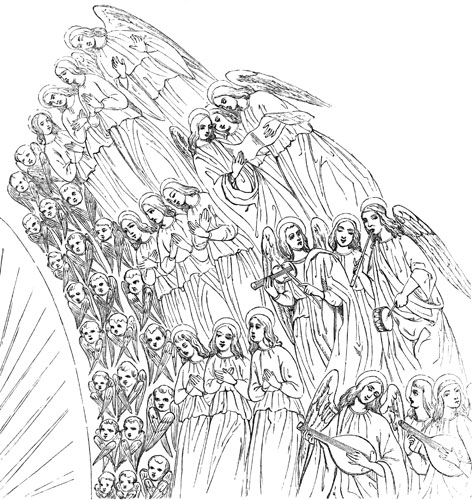
Angel Pictures
There have been many curious conceits introduced into some of the early religious pictures, and two instances in which little seraphim and angels are perched on trees, near the Virgin and Holy Child. The idea seems to be that these “Birds of God” — as Dante calls the angels — are making music and singing for the Divine Infant, some of them also praying for his solace.
Occasionally a series of pictures called the Acts of the Holy Angels has been painted. It consists of eleven strictly Scriptural subjects, usually as follows, but varied in some instances by the introduction of other motives of the same character, as, for example, the angel appearing to Hagar and to Elijah:
I. The Fall of Lucifer.
II. The Expulsion of Adam and Eve from the Garden of Eden.
III. The Visit of Three Angels to Abraham.
IV. The Angel Preventing the Sacrifice of Isaac.
V. The Angel Wrestling with Jacob.
VI. Jacob’s Dream.
VII. The Deliverance of the Three Children from the Fiery Furnace.
VIII. The Angel Slays the Host of Sennacherib.
IX. The Angel Protects Tobias.
X. The Punishment of Heliodorus.
XI. The Annunciation to the Virgin.
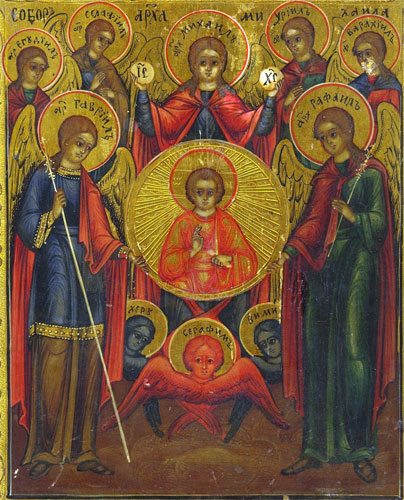
The Angelic Council - Easter Orthodox church icon of the Seven Archangels
Of the seven archangels to whom Milton refers, when he says:
The Seven
Who in God’s presence, nearest to his throne.
Stand ready at command.
only three are recognized by the Christian Church; and when three archangels are seen together, they are Michael, Gabriel, and Raphael. In the Greek Church this representation is regarded as typical of the military, civil, and religious power, and, accordingly, the costumes indicate a soldier, a prince, and a priest.
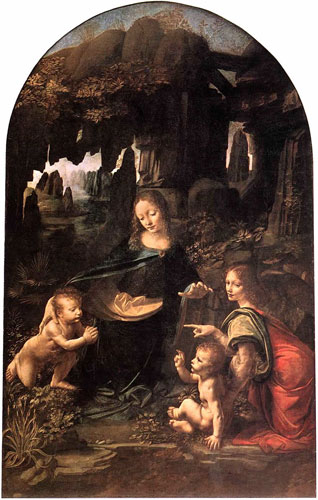
Madonna of the Rocks by Leonardo da Vinci with Uriel in the red robe
But Uriel has not been entirely ignored, even by the Christian Church, and an early tradition teaches that this archangel, and not Christ, accompanied the two disciples on their way to Emmaus. In the book of Esdras we read, “The angel that was sent unto me, whose name was Uriel.” His office was that of interpreter of judgments and prophecies, which Milton recognizes thus:
Uriel, for thou of those Seven Spirits that stand
In sight of God’s high throne, gloriously bright,
The first art wont his great authentic will
Interpreter through highest heaven to bring.

The Cathedral Monreale photographed by Jerzy Strzelecki
In several ancient churches four archangels are represented in the architectural decoration. An example in which they are very splendid is that in the mosaics above the choir arch in the Cathedral of Monreale, Palermo. These colossal, armed figures are impressive, not only from their size, but also because of their apparent realization of their illustrious rank in the order of created beings.
More frequently the four archangels are so represented as to appear to sustain the roof, or vault, in churches where the figure of Christ, or his symbol, the Lamb, is pictured as the central decoration. These are clearly intended to personate the four “who sustain the throne of God.” Their symbols are sceptres or lances; at times they stand erect, like faithful, watchful guardians; again with arms outstretched they seem to uphold the vault on which Christ is portrayed.
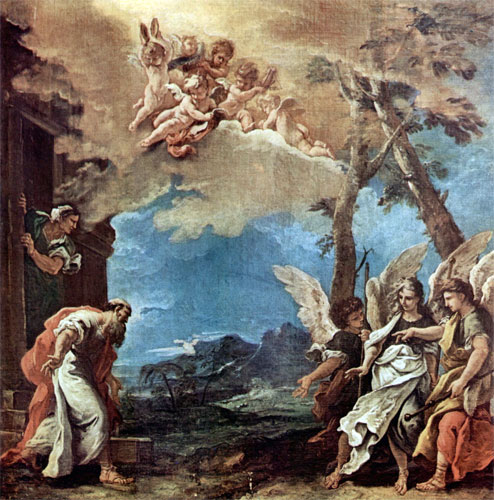
Abraham and the Three Angels by Sebastiano Ricci
The representations of three archangels are more numerous than the above, and are variously treated. In some ancient pictures they have no wings, and appear like men of princely rank and noble character. The visitors of Abraham are often thus represented, which accords with thevHebrew idea of angels at the period when Abraham was thus honored; for it was not until after the captivity, when the Egyptian custom of giving wings to their representations of messengers had been observed, that the cherubim and seraphim covered the mercy-seat with their wings.
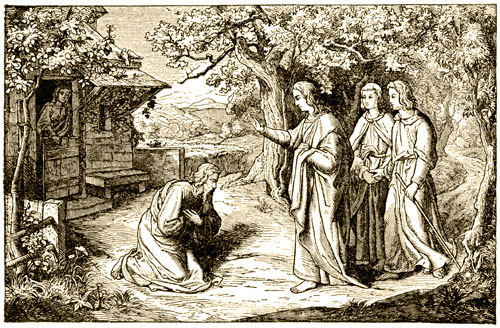
Prophet Abraham and the Three Angels
One of the best known and most beautiful pictures of these angelic visitors is that by Raphael in the fourth arcade of the Loggie of the Vatican, which is shown as an engraving in the image above.
Source: Clement, Clara Erskine.
Angels in Art. Boston: L. C. Page and Company, 1898.
You can find many more Angel Pictures at Christian Image Source.
Seven Holy Angels
Angel Pictures
There have been many curious conceits introduced into some of the early religious pictures, and two instances in which little seraphim and angels are perched on trees, near the Virgin and Holy Child. The idea seems to be that these “Birds of God” — as Dante calls the angels — are making music and singing for the Divine Infant, some of them also praying for his solace.
Occasionally a series of pictures called the Acts of the Holy Angels has been painted. It consists of eleven strictly Scriptural subjects, usually as follows, but varied in some instances by the introduction of other motives of the same character, as, for example, the angel appearing to Hagar and to Elijah:
I. The Fall of Lucifer.
II. The Expulsion of Adam and Eve from the Garden of Eden.
III. The Visit of Three Angels to Abraham.
IV. The Angel Preventing the Sacrifice of Isaac.
V. The Angel Wrestling with Jacob.
VI. Jacob’s Dream.
VII. The Deliverance of the Three Children from the Fiery Furnace.
VIII. The Angel Slays the Host of Sennacherib.
IX. The Angel Protects Tobias.
X. The Punishment of Heliodorus.
XI. The Annunciation to the Virgin.
The Angelic Council - Easter Orthodox church icon of the Seven Archangels
Of the seven archangels to whom Milton refers, when he says:
only three are recognized by the Christian Church; and when three archangels are seen together, they are Michael, Gabriel, and Raphael. In the Greek Church this representation is regarded as typical of the military, civil, and religious power, and, accordingly, the costumes indicate a soldier, a prince, and a priest.
Madonna of the Rocks by Leonardo da Vinci with Uriel in the red robe
But Uriel has not been entirely ignored, even by the Christian Church, and an early tradition teaches that this archangel, and not Christ, accompanied the two disciples on their way to Emmaus. In the book of Esdras we read, “The angel that was sent unto me, whose name was Uriel.” His office was that of interpreter of judgments and prophecies, which Milton recognizes thus:
The Cathedral Monreale photographed by Jerzy Strzelecki
In several ancient churches four archangels are represented in the architectural decoration. An example in which they are very splendid is that in the mosaics above the choir arch in the Cathedral of Monreale, Palermo. These colossal, armed figures are impressive, not only from their size, but also because of their apparent realization of their illustrious rank in the order of created beings.
More frequently the four archangels are so represented as to appear to sustain the roof, or vault, in churches where the figure of Christ, or his symbol, the Lamb, is pictured as the central decoration. These are clearly intended to personate the four “who sustain the throne of God.” Their symbols are sceptres or lances; at times they stand erect, like faithful, watchful guardians; again with arms outstretched they seem to uphold the vault on which Christ is portrayed.
Abraham and the Three Angels by Sebastiano Ricci
The representations of three archangels are more numerous than the above, and are variously treated. In some ancient pictures they have no wings, and appear like men of princely rank and noble character. The visitors of Abraham are often thus represented, which accords with thevHebrew idea of angels at the period when Abraham was thus honored; for it was not until after the captivity, when the Egyptian custom of giving wings to their representations of messengers had been observed, that the cherubim and seraphim covered the mercy-seat with their wings.
Prophet Abraham and the Three Angels
One of the best known and most beautiful pictures of these angelic visitors is that by Raphael in the fourth arcade of the Loggie of the Vatican, which is shown as an engraving in the image above.
Source: Clement, Clara Erskine. Angels in Art. Boston: L. C. Page and Company, 1898.
You can find many more Angel Pictures at Christian Image Source.
Related posts: